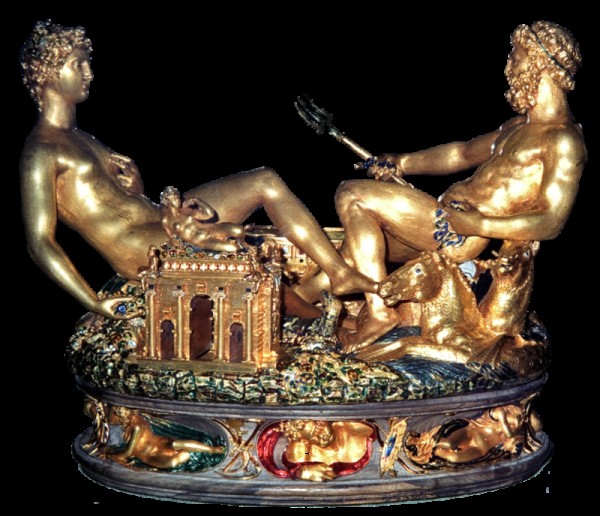Mercury seems to have "magical" properties. It is metal and at the same time a liquid; causes fatal poisoning, but can also heal many diseases ... And people, over the centuries, just couldn't take their hands off it!
Today we know the unusual metal under the symbol Hg, it was known and used already in prehistoric times. Incredible as it may seem, people in China, Japan, Europe and the Americas already knew him back then. It all started with the relatively common cinnabar:mercury sulphide, found in volcanic rocks. It was used in the production of dyes, as well as in metallurgy, as a preservative or pigment in ceramics. Pure mercury can be obtained when firing the mineral, but its vapors cause severe poisoning.
The element can also be absorbed through the skin and digestive system, and then "stuck" forever in bones and organs. It is thanks to this that we know, for example, that the people of southern Portugal used mercury as early as 5400 - 4100 BC:their remains still bear traces of a love for "living silver"!

Emperor Qin Shi Huang Di died of mercury poisoning
Traces of mercury were found in Egyptian tombs built 1500 BC. For medical and aesthetic purposes, it was also used in ancient China - what's more, Qin Shi Huang Di, known as the first emperor, died as a result of poisoning with an alchemical decoction based on this element. The ruler desperately searched for an elixir to ensure his immortality and his court alchemists decided to use liquid metal for some reason ... Mercury was also found among the treasures hidden under the temple of the Great Feathered Serpent in Teotihuacan.
Mercury in the service of beauty
The mysterious metal has greatly contributed to various forms of broadly understood beauty, whether it offers great opportunities in metallurgy or cosmetics.
In particular, goldsmiths took a liking to mercury, who learned to apply gold to various surfaces in antiquity, using amalagmas - that is, mercury solutions of metals. It was a dangerous method: you had to mix one part of gold with as many as nine parts of mercury, and then cover the selected object with this substance. Later, the treatment object was heated, thanks to which the "live silver" evaporated, leaving a delicate and plastic layer of gold.
Unfortunately, mercury fumes are very poisonous, so many goldsmiths have died at work. These deaths contributed to the creation of a specific legend that only true masters of the trade could deal with amalagmatic coating. At the same time, efforts were made to reduce the risk as much as possible:for example, the monk Theophilus (Theophilus) advised in the 12th century never to work on an empty stomach, because mercury vaporized is especially dangerous for hungry people. There was of course no hidden truth to it, but at least the goldsmiths did not die on an empty stomach. The clergyman advised to consume barberry, garlic, pepper and wine before exposure to toxic fumes.
Despite the good intentions of Theophilus, amalagmas were still used, and there were no effective ways to protect them. Worse, mercury vapors are odorless and colorless, making them harder to avoid if necessary. There were therefore spectacular, massive poisonings when covering large areas with gold . For example, in the years 1838-1841, as many as 60 workers were killed during the beautification of the church domes! Fortunately, a new method using a galvanic cell appeared in the 19th century. Despite protests from the community of unrepentant amalagmatic goldsmiths, in 1842 the Commission of the French Academy approved the electroplating method.

It was believed that mercury could improve beauty
On the basis of mercury, cosmetic foundations were also created to mask skin imperfections. They were effective, they made the skin glow. They were often used together with arsenic purem, which also had an impact on the user's health. And that must have been diminished by now:mercury is absorbed through the skin and can cause kidney and liver disease, as well as fatigue, irritability, tremors, depression, paranoia, mood swings, drooling, blackening of the teeth, a metallic taste in the mouth, and finally even death from poisoning. If the user of the mercury cosmetic is pregnant, the baby is also at risk of developing malformations.
Invisible Danger
Although fire gilding has long been discontinued and mercury-based cosmetics have been abandoned (dermatology still uses ointments containing this element, but they are prescribed in exceptional cases), mercury continues to be a major threat to humans on a daily basis. How?
The various compounds formed by "living silver" are used as pesticides in agriculture as well as in industry. Once they get into the environment, they remain odorless and tasteless, so they are very difficult to detect ... The inhabitants of Minamata Bay (Kumamoto Prefecture, Japan), who lived near the Chisso corporation producing plastics, learned about it painfully in the 1950s . The concentration of mercury in the water to which the wastewater from the factories got into did not pose a direct threat to human life and yet - in 1956, doctors discovered the first poisoning. The situation escalated very quickly, and the effects of the invisible poison were discovered until 2001. A total of 2,265 cases of mercury (this is the general name of the complex of symptoms caused by mercury compounds in the body), 1,784 of which were fatal.

Karen Wetterhahn - American chemist
It turned out that the dangerous element accumulated in aquatic organisms, gaining ever greater concentrations in subsequent links of the food chain. Herbivores ate contaminated algae, and they were eaten by predators that were eaten by higher-level predators ... Mercury is not excreted from the body in any way so its concentration in the flesh of the Japanese beloved big fish was deadly.
Mankind remembered this situation as the "Minamata disease" epidemic and awareness of the dangers of mercury has increased.
However, this is not the end of the problems. A similar case, though triggered in a slightly different way, took place in 1971-1972 in Iraq. The bread was baked using grains sprayed with a pesticide containing methylmercury, which was intended only for sowing. Due to this mistake, 6,530 people were hospitalized, 459 people died.
Worst of all poisons
The queen of mercury poisons is certainly a compound called dimethylmercury, which not only successfully hides in the human body and penetrates the blood-brain barrier, but also has the ability to penetrate laboratory protections and be absorbed through the skin. Karen Wetterhahn, who conducted research on a dangerous chemical compound at Dartmouth College in New Hampshire, on August 14, 1996, found this out. As an experienced toxicologist, she was working under a fume hood and in full laboratory gear when a vial containing only 0.5 milliliters of liquid burst. Wetterhahn cleared the workplace, took off the gloves in accordance with health and safety regulations and disposed of in the toxic waste bin. Nevertheless, in the winter of the following year she developed symptoms of dimethylmercury poisoning - research carried out on January 28 showed that the lethal dose of poison in the blood of a woman was exceeded 80 times. Karen passed away on July 8, 1997.
Symptoms of dimethylmercury poisoning are unique in relation to other compounds of this element. The substance binds with cysteine, which strongly influences the functioning of the brain. It causes hallucinations, ataxia, and memory loss. What's worse, we learn about poisoning very late, because dimethylmercury creates only compounds with cysteine in our body, and the process is slow. Typical mercury poisoning manifests itself slightly differently:it causes damage to the central nervous system and the endocrine system . Outward symptoms may include damage to the gums, lips and teeth. Death by exposure to mercury usually occurs as a result of brain damage. Today, such poisoning occurs as a result of exposure to mercury accumulated in the environment, but in the past they had completely different causes ...
Perpetual ball and boiled droppings
“Any ruler who felt a bit indistinct should be advised to lock the door in front of the palace medics, as they regularly prescribed poison. Drugs included lead, mercury, arsenic, antimony, gold and silver. The worse the patient felt, the more heavy metals he had to take, and then he felt even worse. " - we read in "Poison, or how to get rid of your enemies royally" by Eleanor Herman. There is some truth to this, but as it usually is, it all depends on the context.

Ambroise Paré believed in the effectiveness of mercury treatment
The consumption of mercury is certainly not healthy as it causes severe diarrhea. While this is not a serious medical problem today, in the past, dehydration as a result of diarrhea could even lead to death. This does not change the fact that the "living silver" medications for constipation were effective and widely used. Ambrose Paré wrote in 1585:"[Mercury] opens and untangles looped or clogged intestines and pushes forward hard, blocking excrement." This medical genius recommended a rather peculiar treatment:he had to give a pound of liquid mercury to a puppy, then collect its droppings, boil it in vinegar, and drink it.
In the 18th century, a perpetual antimony ball filled with mercury was created. It was put in sugar and swallowed, which caused intestinal irritation and defecation. The ball was used many times, after being fished out of the potty and washed - what's more, there were cases of passing such a device from generation to generation! Back in 1804, while exploring the Wild West, 60% mercury-based laxative pills came in handy. Modern scientists later discovered the exact places where the members of the Lewis and Clark expedition camped, because traces of the element remained in the soil.
Harmful medicine, healing toxin
Another useful property of mercury is ... its toxicity. During the syphilis epidemic, it was very useful because it was able to kill Treponema pallidum spirochetes. Lead and mercury ointment applied in the right places could stop the progression of the disease. Giovanni da Vigo describes a genital dressing soaked in mercury, lanolin and olive oil that has been used for nearly four centuries! Ambrose Paré described cases in which, after the therapy, the pains disappeared and the wounds dried. There was also a risk that, once it enters the bloodstream, the mercury will simply kill the sick person ...
The most drastic method, intended for critically ill patients, was treatment with mercury vapor in a special tent . The method worked like chemotherapy:if the patient survived, no bacteria wanted to live in him anymore. As a result of treatment, the patients had burned gums and respiratory systems, lacerated lips and damage to internal organs, but… there was a chance of survival. Ulrich von Hutten endured eleven such treatments.

Benvenuto Cellini refused to treat syphilis with mercury
Very lucky was Benvenuto Cellini, the goldsmith of King Francis I, who contracted syphilis in 1529 and refused to be treated with mercury - probably knowing all too well the destructive effects of the element. As the disease progressed, his character changed and Cellini made enemies. It got to a point where several partners tried to poison him with a sauce flavored with mercury sublimation. They did not achieve their goal, and meanwhile, the goldsmith, after suffering from unpleasant gastrointestinal ailments ... completely recovered! It turned out that the poison killed the syphilis spirochetes instead of his.
The reverse was the case with the death of the martyr of the French king Charles VII, who died in 1450 while consuming a medicine that was intended to help her in the treatment of food ailments. Modern researchers found that Agnès Sorel struggled with intestinal parasites, for which she took elixirs made of mercury and male handpiece. Analyzes of Charles VII's hair showed mercury levels 10 to 100,000 times the norm!
Ivan IV the Terrible also fell victim to "living silver". While it was not the immediate cause of his death, it is likely that the drugs based on it exacerbated the mood swings of the violent ruler.
It has long been believed among alchemists and mercury doctors that this metal is at the root of all things. "Living silver" was supposed to have the power to transform into any other substance, therefore research and attempts to apply it in various areas of life were not limited to. Today we know that the "bizarre" nature of mercury is due to the laws of physics. However, this does not mean that we are no longer fascinated by liquid metal with a wide range of applications.
Bibliography:
- Bakir, F., et al., Methhylmercury Poisoning in Iraq. Science, July 20, 1973.
- Emslie, S., et al., Chronic mercury exposure in Late Neolithic / Chalcolithic populations in Portugal from the cultural use of cinnabar. Sci Rep, 2015, accessed January 24, 2020.
- Goldwater, L., Mercury:A History of Quicksilver. London 1972.
- Kłys, M., With mercury (and…) for centuries. Arch. Med. Court. Criminol., 2010.
- www.science.sciencemag.org/content/181/4096/230, accessed January 24, 2020.
- www.galvanoaurum.com/zlocenie-antyczne/, accessed on:24/01/2020
